Rosalba Carriera
Rosalba Carriera (12 January 1673[1][2] – 15 April 1757) was a Venetian Rococo painter. In her younger years, she specialized in portrait miniatures. It is for this that she was able to build a career in portraiture. Carriera would later become known for her pastel work, a medium appealing to Rococo styles for its soft edges and flattering surfaces. She is remembered as one of the most successful women artists of any era.[3]
Rosalba Carriera | |
|---|---|
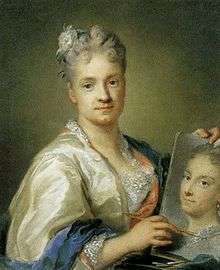 Self-portrait, 1715 | |
| Born | 12 January 1673 Venice |
| Died | 15 April 1757 (aged 84) Venice |
| Nationality | Italian |
| Known for | Portrait painting |
| Movement | Rococo |
Biography
Born in Venice with two sisters, Carriera's family was from the lower-middle-class in Venice, and as a child, she began her artistic career by making lace-patterns for her mother, who was engaged in that trade. However, when interests in lace waned and the industry began to falter, Carriera had to find a new means of providing for herself and her family.
The popularity of snuff-taking gave her an opportunity to do just that. Carriera began painting miniatures for the lids of snuff-boxes, and was the first painter to use ivory instead of vellum for this purpose. Gradually, this work evolved into portrait-painting, for which she pioneered the exclusive use of pastel. Prominent foreign visitors to Venice, young sons of the nobility on the grand tour and diplomats for example, clamored to be painted by her.[4] The portraits of her early period include those of Maximilian II of Bavaria; Frederick IV of Denmark; the 12 most beautiful Venetian court ladies; the "Artist and her Sister Naneta" (Uffizi); and August the Strong of Saxony, who acquired a large collection of her pastels.[5]
By 1700, Carriera was already creating miniatures and by 1703 she completed her first pastel portraits.[6] In 1704, she was made an 'Accademico di merito' by the Roman Accademia di San Luca, a title reserved for non-Roman painters.

By 1721, Carriera left Venice for Paris, as portraits by her were in great demand. While in Paris, Carriera was a guest of the great amateur and art collector, Pierre Crozat. She painted Watteau, all the royalty and nobility from the King and Regent downwards, and was elected a member of the Academy by acclamation.[7][8] Her brother-in-law, the painter Antonio Pellegrini, married to her sister Angela, was also in Paris that year. Pellegrini was employed by John Law, a Scottish financier and adventurer, to paint the ceiling of the Grand Salle in Law's new bank building.
Carriera's other sister, Giovanna, and her mother, were members of the party in France. Both sisters, particularly Giovanna, helped her in painting the hundreds of portraits she was asked to execute. This was because she undertook a lot of work in order to support her family.[9] Carriera's diary of these 18 months in Paris was later published by her devoted admirer, Antonio Zanetti, the Abbé Vianelli, in 1793. Her extensive correspondence has also been published.[10]
In the short time she spent in Paris, Carriera's work contributed to forming the new aristocratic tastes of the court and by extension, the tastes of Parisians. No longer did art serve only the monarchy's needs. Her freedom, colorfulness and charms were injected into the Rococo style (which she was the face behind) which soon dominated the arts.[9] Despite her triumph in Paris, she returned to her home in Grand Canal, Venice in 1721. Carriera, with her sister Giovanna in tow, visited Modena, Parma, and Vienna, and was received with much enthusiasm by rulers and courts.
In later life, Carriera made a long journey to the royal court in Vienna, Austria. While there, Holy Emperor Charles VI became her benefactor and was fully committed to supporting her work. The Emperor amassed a large collection of more than 150 of her pastels. In return, the empress worked underneath her and received formal artistic training.[7] The works she executed there were later to form the basis of the large collection in the Alte Meister Gallery in Dresden.
After her sister Giovanna's death in 1738, Carriera fell into a deep depression which was not aided by the loss of her vision (which might have been damaged by miniature painting in her youth) some years later. She underwent two unsuccessful cataract surgeries but ended up losing her vision completely.[11] She outlived all her family, spending her last years in a little house in the Dorsoduro district of Venice, where she died at the age of 84.
By the time of Carriera's death, the Rococo style was not as popular as before. Despite this, she was still a strong influence for many of the women artists that came after her, such as Catherine Read, Adélaïde Labille-Guiard and Élisabeth Vigée Le Brun.
Training
Carriera's mother taught her the art of lace making, but the artworks she became famous for were a result of her own self learning. Despite this, there is much speculation surrounding her education in art. It is said that the French painter Jean Steve encouraged her to make miniatures on ivory to decorate the lids of snuffboxes.[7] Some also claim that she received initial instruction in oil technique from the Venetian painter Giuseppe Diamantini.[12]
Despite this, Carriera would share her talents with her sisters Giovana and Angela and later in life had female students as Marianna Carlevarijs, Margherita Terzi and Felicità Sartori.[13]
Influence
Carriera's influence would spread widely among many. In 1720 she provided King Louis XV with a portrait that completed the transition from the previously accepted style of the court. It was a shift between what looked powerful and a decorative style with international appeal.[9] She revolutionized the world of technology by binding colored chalk into sticks, which led to the development of a much wider range of prepared colors. This expanded the availability and the usefulness of the pastel medium.[9]
Although negatively dubbed ‘The Rococo’ by Maurice Quai, a follower of the neoclassicist Jacques-Louis David,[7] Carriera played an important role in popularizing the style in France and later England, where George III was a major collector of her work.
Despite her renown and contribution to an established manner, Carriera is "often treated as an exception, a rarity as a woman artist"[13] and very often ignored. When the Rococo went out of mode, Carriera's name and her impact was dismissed and that had very much to do with gender as well.
Rosalba Carriera is one of the main characters appearing in the novel The Laws of Time (2019) by Andrea Perego.
Works
Carriera was the first female painter to initiate a new style in the art community.[14] The Rococo style emphasized the use of pastel colors; spontaneous brush strokes, dancing lights, subtle surface tonalities and a soft, elegant and charming approach to subject matter. She was known for dragging the sides of white chalk across an under-drawing of darker tones to capture the shimmering texture of lace and satin. She was also able to highlight facial features and the soft cascades of powdered hair.[9] Because of her, artists created work in the style for nearly a century.
Carriera had many patrons who were interested in her work. Her earliest known pastel portrait depicts the collector Anton Maria Zanetti (1700) who procured many works by the artist and promoted her to other collectors when he travelled throughout Europe. Joseph Smith was another one of her admirers and he too collected a great amount of her works. King George III later purchased these pieces in 1762. That collection contained one of many of her self-portraits.[15]
Her best-known self-portrait is one she contributed to the Medici collection of self-portraits at the Uffizi Gallery in Florence. This piece was different because she veered away from idealizing herself, as was a custom of the era. Instead, she was brusque and honest in her representation, featuring a larger nose, thin lips and a deep dimple in her chin. She holds a portrait of her sister and assistant Giovanna, whom she was very close to.[15]
Her self-portrait work diverges from typical expectations of women artists of the time by aiming for an unvarnished appearance. One such example is Self-Portrait as an Old Woman (1746), whose mismatched eyes hint at the eye problems which plagued her in later life.[16]
Carriera was not just a portrait painter, even though that was her subject matter of choice due to her profession. She also created a few allegorical pieces, including ‘The Four Seasons’, ‘The Four Elements’ and ‘The Four Continents’. These allegories were represented by beautiful, nymph like and barely clothed women holding symbols that referenced the meaning of the piece.[7]
Gallery

Self-portrait 
Self-portrait 
Self-Portrait 
Self Portrait as Winter 
Young Girl 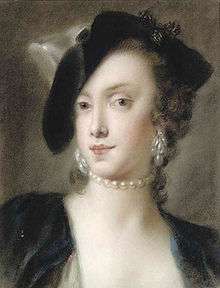
Caterina Sagredo Barbarigo 
Felicita Sartori in Turkish costume 
Young Girl Holding a Monkey 
Summer 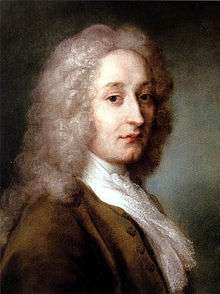
Antoine Watteau 
French Consul Le Blond 

Young Cavalier 
Louis XV of France 

Gentleman in Red 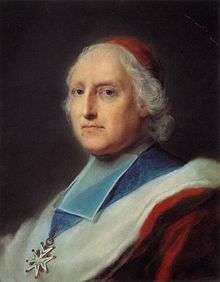
Cardinal Melchior de Polignac 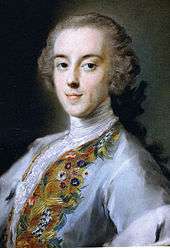
Legacy
Carriera was best known for her innovative approach to pastels, which had previously been used for informal drawings and preparatory sketches. She was also credited with pastel as a medium for serious portraiture that redefined the Rococo manner.[17]
References
- Jeffares, Neil. "Dictionary of Pastellists before 1800" (PDF). pastellists.com.
- "Rosalba Carriera". finestresullarte.info.
- "Rosalba Carriera | National Museum of Women in the Arts". nmwa.org. Retrieved 6 March 2017.
- Rosalba Carriera by Bernardina Sani, Umberto Allemandi & co. Ed. (1988), as reviewed by Francis Russell, The Burlington Magazine (1989) p857
- New International Encyclopedia
- Heller, Nancy G. (2003). Women Artists. New York: Abeville Press. p. 55.
- "Rosalba Carriera facts, information, pictures | Encyclopedia.com articles about Rosalba Carriera". www.encyclopedia.com. Retrieved 6 March 2017.
- New International Encyclopedia
- Chadwick, Whitney (2012). Women, Art and Society. London: Thames & Hudson. ISBN 9780500204054.
- Rosalba Carriera: lettere, diari, frammenti by Bernardina Sani, Leo S. Olschski ed., Firenze (1985), as reviewed by Francis Haskell in The Burlington Magazine 1987. p122-123
- Dabbs, Julia K. "Vision and Insight: Portraits of the Aged Woman Artist, 1600–1800." ARCADE. Stanford, 31 May 2012.
- Hobbes, James R. (1849). Picture collector's manual adapted to the professional man, and the amateur. T&W Boone, 29 Bond Street. p. 74.
- Parker, Pollock, Rozsika, Grisielda (2013). Old Mistresses: Women, Art & Ideology. I.B. Tauris.
- Phaidon Editors (2019). Great women artists. Phaidon Press. p. 89. ISBN 0714878774.
- Russo, Kathleen. "Carriera, Rosalba". Europe, 1450 to 1789: Encyclopedia of the Early Modern World. Gale – via Encyclopedia.com.
- Frances Borzello, Seeing Ourselves: Women's Self-Portraiture 1998
- "Pastel Masterpiece Unveiled at Institute..." EDCHADWICK. The Free Library. Birmingham Post & Mail Ltd. 4 February 2010.
Resources
- Consult the biographies of Sensier, with translation of her diary (Paris. 1865), Von Hoerschelmann (Leipzig, 1908), and Malamani (Milan, 1910).
- Elsa Honig Fine puts Rosalba Carriera in context with other women artists in Women and Art: A History of Women Painters and Sculptors from the Renaissance to the 20th Century (London & Montclair, 1978).
- Sensier's (highly annotated) version of her journal of two years in Paris (1720–1721) is available from two sources on-line in French:
- Journal de Rosalba Carriera pendant son séjour à Paris en 1720 et 1721 / publié en italien par Vianelli; trad., annoté et augm. d'une biographie et de documents inédits sur les artistes et les amateurs du temps, par Alfred Sensier: J. Techener (Paris) 1865
- Rosalba Carriera, Alfred Sensier, Journal de Rosalba Carriera pendant son séjour à Paris en 1720 et 1721: Publié en italien par Vianelli. Traduit, annoté et augm. dùne biogr. et de documents inédits sur les artistes et les amateurs du temps 1865, Techener
External links
| Wikimedia Commons has media related to Rosalba Carriera. |
- Neil Jeffares, Dictionary of pastellists before 1800, online edition
- Anna Kleinman Research Files on Rosalba Carriera, English translations of the correspondence and diary of Rosalba Carriera in The Frick Collection/Frick Art Reference Library Archives.